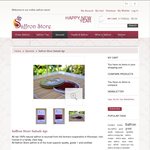January Sale;
100% Pure Persian Saffron 4gr. $20.50 - Free Shipping
100% natural saffron is sourced from the farmers cooperative in Khorasan, Iran.
Comes in a handy, clear bag.
All Saffron Store saffron is of the most superior quality, grade 1 and certified.
100% Pure Persian Saffron, 4gram Clear Pack, $20.50 (Was $29.95) + Free Shipping @ Saffron Store
Last edited 01/01/2014 - 15:53 by 1 other user
Related Stores
closed Comments

"All Saffron Store saffron is of the most superior quality, grade 1 and certified."
Grade 1 on what grading system? And certified what? And by whom?
Not trying to be a hater, love the idea of sourcing goods from farmers co-ops and prefer supporting Aussie small businesses compared to the multinationals, I just get suspicious when quality claims are made without anything to back them up.

It states in the details "The Saffron Store brand is licensed by the Iranian Ministry of Agriculture"

Looks a good price saffron. I will give it a try. 4gm at coles and using masterfood brand cost around $50.

Got one as well. Will post a review once I use it.

For saffron Grades please check the link below:
http://en.wikipedia.org/wiki/Saffron
From Wikipedia.org
Grades
Red threads and yellow styles.Saffron is graded via laboratory measurement of crocin (colour), picrocrocin (taste), and safranal (fragrance) content.[32] Determination of non-stigma content ("floral waste content") and other extraneous matter such as inorganic material ("ash") are also key. Grading standards are set by the International Organization for Standardization, a federation of national standards bodies. ISO 3632 deals exclusively with saffron and establishes four empirical colour intensity grades: IV (poorest), III, II, and I (finest quality). Samples are assigned grades by gauging the spice's crocin content, revealed by measurements of crocin-specific spectroscopic absorbance. Graders measure absorbances of 440-nm light by dry saffron samples. Higher absorbances imply greater crocin concentration, and thus a greater colourative intensity. These data are measured through spectrophotometry reports at certified testing laboratories worldwide. These colour grades proceed from grades with absorbances lower than 80 (for all category IV saffron) up to 190 or greater (for category I). The world's finest samples (the selected most red-maroon tips of stigmas picked from the finest flowers) receive absorbance scores in excess of 250. Market prices for saffron types follow directly from these ISO scores. However, many growers, traders, and consumers reject such lab test numbers. They prefer a more holistic method of sampling batches of thread for taste, aroma, pliability, and other traits in a fashion similar to that practised by practised wine tasters.[33]
Valuable stigmas, or threads, are tediously plucked, piled, and dried.Despite such attempts at quality control and standardisation, an extensive history of saffron adulteration—particularly among the cheapest grades—continues into modern times. Adulteration was first documented in Europe's Middle Ages, when those found selling adulterated saffron were executed under the Safranschou code.[34] Typical methods include mixing in extraneous substances like beets, pomegranate fibres, red-dyed silk fibres, or the saffron crocus's tasteless and odourless yellow stamens. Other methods included dousing saffron fibres with viscid substances like honey or vegetable oil. However, powdered saffron is more prone to adulteration, with turmeric, paprika, and other powders used as diluting fillers. Adulteration can also consist of selling mislabelled mixes of different saffron grades. Thus, in India, high-grade Kashmiri saffron is often sold and mixed with cheaper Iranian imports; these mixes are then marketed as pure Kashmiri saffron, a development that has cost Kashmiri growers much of their income
" From Wikipedia, the free encyclopedia". http://en.wikipedia.org/wiki/Saffron


Link?